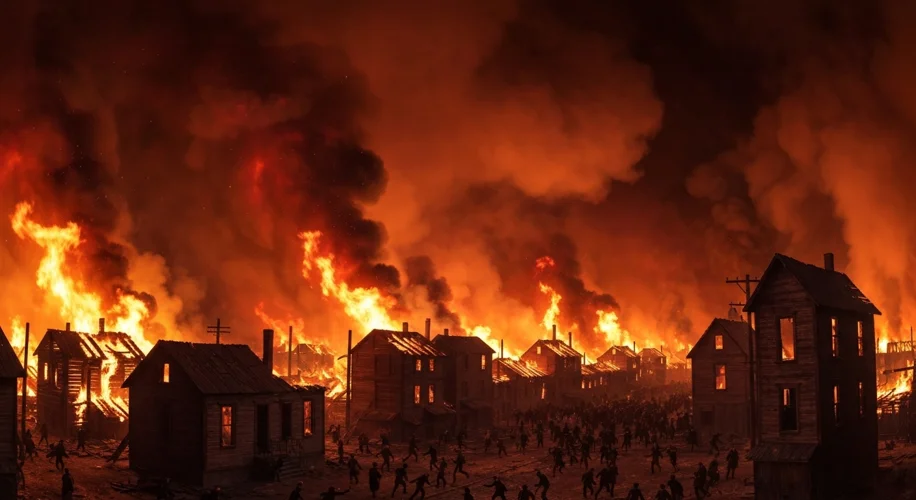The autumn of 1871 in Chicago was a season of dry winds and abundant fuel. The city, a rapidly growing metropolis built largely of wood, teemed with a restless energy. Its streets, often unpaved and choked with debris, were a tinderbox waiting for a spark. That spark, legend has it, was struck on the evening of October 8th, 1871, in a humble barn at the corner of DeKoven and Taylor Streets.
The popular tale, though perhaps apocryphal, points to the O’Leary family cow, allegedly kicking over a lantern. While the exact cause remains debated by historians, the effect was undeniable and catastrophic. Within hours, a conflagration of unimaginable scale was unleashed upon Chicago.

The fire fed on the city’s very construction. Buildings, packed tightly together, were made of wood, and many had wooden sidewalks and even wooden-paved streets. The city had also experienced a prolonged drought, leaving everything dangerously dry. Furthermore, the winds that night were unusually strong, fanning the flames and carrying burning embers across the city, igniting new fires miles ahead of the main blaze.
The fire department, already exhausted from a large fire the previous day, was overwhelmed. Their equipment, including horse-drawn steam pumpers, struggled to keep up with the inferno’s insatiable appetite. The very water mains that should have supplied their hoses were, in some areas, compromised by the heat or simply insufficient to combat the raging inferno.
As the fire advanced, a wave of over 100,000 people found themselves homeless, fleeing with whatever possessions they could carry. The vibrant city center, a testament to American ambition and industry, began to crumble. Churches, theaters, businesses, and homes were reduced to smoldering ruins. The imposing courthouse, with its heavy stone walls, proved no match for the fire’s intensity, its iron cupola melting and collapsing.
Panic and desperation turned to chaos. Families were separated in the frantic evacuation. The air was thick with smoke and the terrifying roar of the flames, punctuated by the sounds of collapsing structures and the cries of the displaced. Many sought refuge near Lake Michigan, huddling on the shores as the fire raged behind them, the sky above them an apocalyptic canvas of orange and black.
The fire raged for two days, finally being brought under control on October 10th. When the smoke cleared, Chicago was a landscape of devastation. An estimated 17,500 buildings had been destroyed, covering over 2,000 acres. The economic toll was staggering, estimated at nearly $200 million in today’s currency. More tragically, the death toll, though difficult to ascertain precisely, is believed to have been between 200 and 300 people.
Yet, from this seemingly absolute destruction, Chicago began to rebuild. The very materials that had fueled the fire—wood—were largely replaced with brick and stone. The fire, in a tragic twist of fate, cleared the way for modern urban planning and architectural innovation. Architects and engineers, undeterred, saw an opportunity to design a more resilient and grander city.

Within a few years, Chicago was not only rebuilt but was emerging as a global center for commerce and culture. The fire spurred the development of the skyscraper, with architects pushing the boundaries of height and design. The city’s infrastructure was improved, and its economy, fueled by the surrounding agricultural heartland and its strategic position as a transportation hub, boomed once more.
The Great Chicago Fire serves as a stark reminder of the fragility of even the most ambitious human endeavors in the face of nature’s power. But more importantly, it stands as a testament to the indomitable spirit of human resilience. The city that burned became a phoenix, rising from its ashes stronger, more innovative, and more determined than ever before. It’s a story of loss and devastation, yes, but ultimately, it is a story of rebirth and the enduring power of hope.

